I can’t stress enough how much a Rheem water softener has changed my daily life. Hard water was wreaking havoc in my home—stiff laundry, spotty dishes, and that annoying film on my skin after a shower.
After installing a Rheem Preferred Series water softener, those problems vanished. The water feels silky, my appliances are happier, and I’m saving money on soap and maintenance. If you’re tired of hard water’s downsides, trust me, this is a game-changer you need.
Let me walk you through my experience and why it’s worth every penny.
My Journey With The Rheem Water Softener
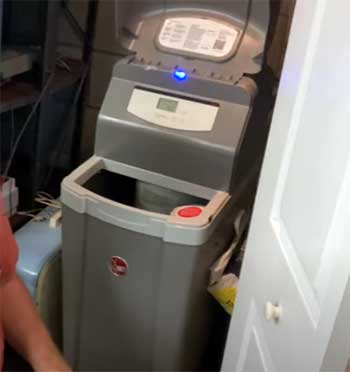
When I moved into my new home a couple of years ago, I didn’t think much about water quality.
I mean, water is water, right?
Wrong.
I quickly noticed my dishes coming out of the dishwasher with white spots, my clothes feeling stiff, and my skin feeling dry after every shower.
A quick test confirmed my suspicions: my water was hard, clocking in at 15 grains per gallon (GPG).
That’s when I decided to invest in a water softener, and after some research, I landed on the Rheem Preferred 32,000 Grain Water Softener. It’s been a lifesaver, and I’m excited to share my experience.
Installing the Rheem wasn’t a walk in the park, but it wasn’t rocket science either. I’m no plumber, but with the included DIY kit and some YouTube tutorials, I managed to set it up over a weekend.
The instructions were a bit technical, leaning toward those with plumbing experience, but I muddled through. Once it was up and running, the difference was immediate. My water hardness dropped to 7 GPG right after installation, and I could feel the softness in every shower.
Soap lathered up like a dream, and my hair felt less like straw.
What stood out most was the Rheem Learning Technology. It’s like the softener has a brain, figuring out my household’s water usage patterns and regenerating only when needed. In my home of three people and a dog, we use a fair amount of water, but the system adapted quickly, using minimal salt.
I also loved the low-salt indicator light—it’s a small thing, but it saved me from constantly checking the brine tank. After a few months, I noticed my water heater was running more efficiently, and my utility bills dipped slightly, which was a nice bonus.
The Rheem Preferred 32,000 Grain model fits perfectly in my utility closet, thanks to its compact, single-tank design. It’s not bulky, and the hinged lid makes refilling salt a breeze. I did run into a hiccup when a connector clip was missing from the kit, but Rheem’s customer service sent a replacement within a few days.
Overall, my experience has been overwhelmingly positive, and I’m thrilled with how it’s transformed my water quality.
Pros of Rheem Water Softeners
- Affordable Price Point
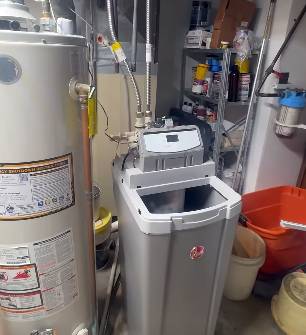
Let’s talk money. Rheem water softeners are a steal compared to other brands.
I paid around $420 for my 32,000-grain model, which is a bargain for the features it offers.
Most comparable softeners start at $800 and can climb to $3,000.
With Rheem, you’re getting high performance without draining your wallet.
Even if something goes wrong, the low cost makes replacing parts or even the whole unit less painful than with pricier brands.
- Smart Learning Technology
The Rheem Learning Technology is a standout. It tracks how much water you use and adjusts the regeneration cycle to match your habits. In my house, we tend to use more water on weekends for laundry and baths.
The softener learned this pattern within a couple of weeks and now regenerates on Thursday nights, ensuring we never run out of soft water. This not only saves water but also cuts down on salt usage—up to 40% less than traditional softeners, according to Rheem’s testing.
- Space-Saving Design
I live in a modest home, so space is at a premium. The Rheem’s single-tank, cabinet-style design is a godsend. It combines the resin and brine tanks into one sleek unit, measuring about 43.5 inches tall and 15.25 inches wide.
It fits snugly in my utility closet without eating up valuable space. Plus, the angled design of the salt tank makes loading salt pellets super easy, even for someone like me who’s not exactly a bodybuilder.
- High Flow Rates
I was worried a water softener might tank my water pressure, but Rheem’s high-flow valve keeps things flowing smoothly. My unit handles up to 1-inch plumbing, which is perfect for my two-bathroom home.
Even when the shower, dishwasher, and washing machine are running simultaneously, I haven’t noticed a drop in pressure. This is a big win for anyone with a busy household.
- Iron Reduction Capabilities
Beyond softening water, my Rheem tackles iron, which was a surprise bonus. My water had a slight reddish tint from ferrous iron, leaving stains on my sinks. The softener, when set correctly, reduced the iron content significantly.
My toilets and showers are now stain-free, and I don’t have to scrub as often. This dual functionality makes Rheem a versatile choice for homes with multiple water quality issues.
- NSF Certification
I’m a bit of a stickler for quality, so I was pleased to learn Rheem softeners are NSF Standard 44 certified for hardness and iron reduction, as well as NSF Standard 372 for lead-free components.
This gave me peace of mind knowing my water is not only softer but also safer. It’s a small detail, but it shows Rheem’s commitment to quality.
Not-So-Good Parts of Rheem Water Softeners
- Tricky Installation for Beginners
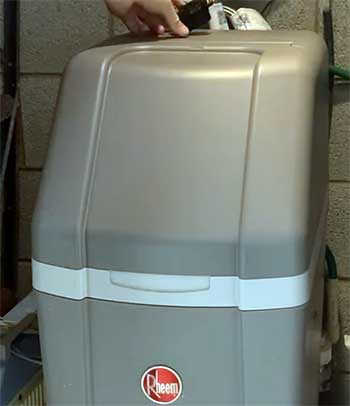
I’ll be honest—setting up the Rheem wasn’t a total breeze.
The instructions assume you know your way around pipes, which I didn’t.
I had to solder copper connectors and deal with a minor leak until I figured out the bypass valve.
If you’re not handy, you might need a plumber, which could add $200-$500 to the cost.
Rheem does offer installation support, but I wish the manual was more beginner-friendly.
- Plastic Tank Concerns
The tank on my Rheem is made of plastic, which keeps costs down but raises durability questions. While it’s held up fine for me so far, I’ve read reviews from others who worry about cracks or leaks over time, especially in harsh climates.
The 10-year tank warranty helps ease my mind, but I’d prefer a sturdier material like fiberglass for long-term peace of mind.
- Limited Warranty Coverage
Rheem’s warranty is a mixed bag. You get one year on parts and labor, three years on electronics, and 10 years on the tank, which sounds decent. But extending the parts warranty to five years requires buying Rheem’s proprietary cleaner every four months.
This feels like a sneaky way to push their products, and I’d rather just pay a one-time fee for a longer warranty. The three-year electronics warranty also feels short, given how often those components can fail.
- No Salt-Free Options
If you’re eco-conscious or don’t want sodium in your water, Rheem might disappoint. They only offer salt-based softeners, which add sodium to your water and require regular salt refills.
This isn’t a dealbreaker for me, but I know some folks prefer salt-free conditioners like SpringWell’s FutureSoft, which don’t increase sodium levels or need as much maintenance. It’s a gap in Rheem’s lineup that could limit its appeal.
- Wi-Fi Features Limited to Top Model
The Wi-Fi-enabled Preferred Platinum model with the iQua app sounds amazing—remote monitoring, salt alerts, and even a shut-off valve option. But it’s only available on the priciest 42,000-grain model, which costs about $609.
My 32,000-grain unit doesn’t have this, and I wish Rheem offered Wi-Fi capabilities across the board. It’s a small gripe, but in 2025, smart features feel like they should be standard.
Maintenance Tips For Your Rheem Water Softener
- Check Salt Levels Regularly
Your Rheem’s low-salt indicator is a lifesaver, but don’t rely on it entirely. I check my brine tank every couple of weeks to ensure it’s at least half-full. A 40-pound bag of salt lasts my household about a month, and I use evaporated salt pellets with less than 1% impurities, as Rheem recommends.
Avoid block salt—it can clog the system. Keeping the tank topped up ensures consistent softening and prevents hard water from sneaking back in.
- Use Rheem Water Softener Cleaner
To keep your softener in top shape, add Rheem’s Water Softener Cleaner every four months. It’s a simple process: pour it into the brine tank, and it helps prevent mold, mildew, and resin buildup.
I found it easy to use, and it’s a small price to pay for extending the warranty to five years. Just set a calendar reminder so you don’t forget—this step is key to longevity.
- Clean the Brine Tank Annually
Once a year, I give my brine tank a thorough cleaning. Empty the salt, scrub the tank with soapy water, and rinse it out. I add a quarter-cup of bleach mixed with water, let it sit for 15 minutes, then rinse again. This keeps iron buildup and gunk at bay.
It’s a bit messy, but doing it outside makes it easier. A clean tank means your resin beads work better and last longer.
- Monitor Regeneration Cycles
Your Rheem’s Learning Technology handles regeneration, but it’s worth keeping an eye on. My unit regenerates every few days, using about 37 gallons of water per cycle. If you notice it regenerating too often (say, daily), it might be a sign of high water hardness or a settings issue.
Check the manual or call Rheem’s support to tweak the settings. This keeps salt and water usage in check.
- Replace Resin Beads Every 5-10 Years
The resin beads in your softener do the heavy lifting, but they don’t last forever. Depending on your water’s hardness and usage, they’ll need replacing every 5 to 10 years. I haven’t hit this point yet, but I’ve budgeted about $200 for resin and gravel when the time comes.
It’s a DIY job if you’re comfortable, or you can hire a pro. Regular maintenance like cleaning helps extend their life.
- Test Your Water Periodically
I test my water hardness every few months using test strips to ensure the softener is doing its job. My post-installation reading of 7 GPG has stayed consistent, but if you notice a spike, it could mean the resin needs attention or the system needs recalibration.
Testing is quick and cheap, and it gives you peace of mind that your softener is performing.
Comparing of Rheem Water Softener To Other Brands
I’ve been thrilled with my Rheem Preferred 32,000 Grain Water Softener, but how does it stack up against other big names like ScaleBlaster, NorthStar, and Kinetico?
I’ve done my homework, comparing features, performance, and value to help you decide what’s best for your home. Here’s a breakdown of how Rheem holds its own against these competitors.
- Rheem Vs. ScaleBlaster: Technology and Effectiveness
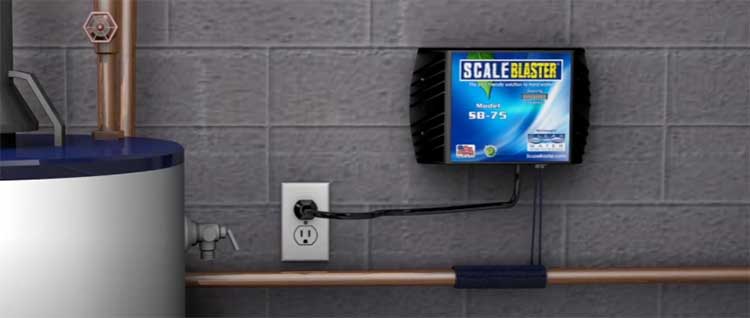
ScaleBlaster offers a salt-free, electronic water conditioner that uses electromagnetic waves to prevent scale buildup, priced around $600. It’s a low-maintenance option—no salt, no resin, no regeneration cycles.
I was tempted by the eco-friendly appeal, but ScaleBlaster doesn’t soften water; it only reduces scale. My Rheem, at $420, actually softens water, making my showers feel luxurious and my dishes spot-free.
ScaleBlaster’s compact wall-mounted unit is great for tight spaces, but it doesn’t tackle iron like Rheem does. For true water softening on a budget, Rheem’s salt-based system outperforms ScaleBlaster’s conditioning approach.
- Rheem Vs. NorthStar: Price and Features
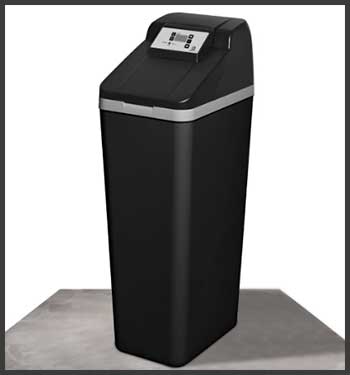
NorthStar’s 31,000-grain water softener, retailing at about $800, is a direct competitor to my Rheem.
It boasts a high-efficiency valve and a digital control panel, similar to Rheem’s Learning Technology.
However, NorthStar’s dual-tank design takes up more space than Rheem’s sleek, single-tank unit, which fits perfectly in my utility closet.
NorthStar’s flow rate of 8 GPM is decent but falls short of Rheem’s 11.6 GPM, which handles my busy household’s demands effortlessly.
While NorthStar offers a lifetime warranty on the tank compared to Rheem’s 10 years, the $380 price gap makes Rheem the better value for similar performance.
- Rheem Vs. Kinetico: Performance and Maintenance
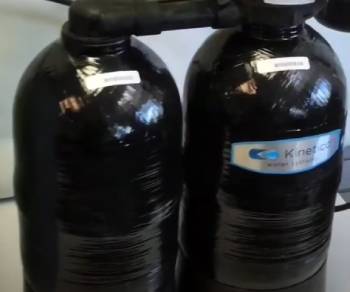
Kinetico’s Premier Series, starting at $1,500, is a premium option with a non-electric, twin-tank design that ensures continuous soft water, even during regeneration.
It’s ideal for large households with high water usage.
My Rheem, while efficient, regenerates every few days, which could interrupt soft water supply briefly.
Kinetico’s 12 GPM flow rate edges out Rheem’s, but its steep price and larger footprint were dealbreakers for my modest home.
Kinetico’s maintenance is minimal, but you’re locked into their proprietary filters, which can get pricey. Rheem’s DIY-friendly maintenance and lower upfront cost make it more accessible for folks like me.
Rheem’s Edge in Affordability and Versatility
Across the board, Rheem stands out for its balance of affordability and performance. At $420-$609, it undercuts NorthStar and Kinetico while offering comparable softening and iron reduction.
ScaleBlaster’s salt-free approach is great for eco-conscious users, but it can’t match Rheem’s ability to deliver truly soft water. Rheem’s Learning Technology and compact design give it an edge for small to medium homes, though Kinetico might be better for larger families.
For my needs—budget, space, and effectiveness—Rheem hits the sweet spot.
Frequently Asked Questions (FAQs)
Absolutely, Rheem water softeners are high-quality. My 32,000-grain model is NSF-certified for hardness and iron reduction, ensuring safe, effective performance. The Learning Technology optimizes salt and water use, and the 10-year tank warranty adds reliability. While the plastic tank raises some durability concerns, I’ve had no issues, and customer reviews praise their effectiveness and affordability.
With proper maintenance, Rheem water softeners can last 10 to 15 years. The resin beads typically need replacing every 5 to 10 years, depending on water hardness and usage. My unit’s still going strong after two years, and regular cleaning with Rheem’s cleaner helps extend its life. The 10-year tank warranty also provides solid protection.
Rheem Manufacturing Company, founded in 1925 by Richard and Donald Rheem, produces these softeners in the USA. Originally known for water heaters, Rheem has nearly a century of expertise in water treatment. Their softeners are designed, engineered, and built with a focus on innovation and quality, which I’ve experienced firsthand.
If your Rheem is guzzling salt, it could be due to high water hardness, frequent regeneration, or incorrect settings. My unit used more salt initially before the Learning Technology adjusted to my usage. Test your water’s hardness and check the manual to fine-tune settings. If it regenerates daily, call Rheem’s support—they’re quick to help troubleshoot.
Why Rheem Is Your Best Bet For Soft Water?
I’ve been thrilled with my Rheem water softener, and I’m confident you will be too. It’s affordable, smart, and delivers silky water that makes showers, laundry, and dishes feel luxurious. Despite a few quirks like tricky installation and a plastic tank, the pros far outweigh the cons.
For small to medium households, Rheem offers unbeatable value. Don’t let hard water ruin your home—grab a Rheem softener and feel the difference today.
